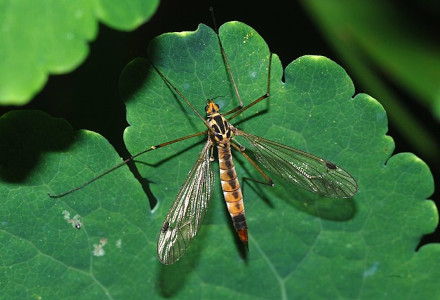
Photgrapher: Nowozin
Public Domain Image
Crane Fly Facts
- The Crane Fly serves as the collective name for any member of an enormous Family, which includes roughly4,250 known species worldwide.
- Most members of this Family possess oversized wings. Despite the great size of their wings, most of these invertebrates remain remarkably poor fliers.
- Insects of this type remain well-known for the slender bodies and extremely long legs. These oversized appendages make the creature appear far larger than it really is.
- Also, many species of Crane Fly are often mistaken for mosquitoes due to the similar size and shape.
- Unfortunately, many of the varieties of this invertebrate have become invasive, and are considered agricultural pests in parts of the world.
Crane Fly Physical Description
The various species of Crane Fly understandably vary greatly in size and overall appearance. Some tropical ones occasionally attain wingspans of up to 4 in (100 mm) in width.
In all varieties, the body develops slender and elongated. The highly elongated legs develop stilt-like, and also easily detach from the body.
Colors vary between species, of course, but some remain predominant. These typically include combinations of brown, gray, and yellow.
Sexual dimorphism is present in most species, in regards to the wings. Among females, these usually remain rather rudimentary.
Kingdom: Animalia
Phylum: Euarthropoda
Class: Insecta
Order: Diptera
Family: Tipulidae
Photographer: Alvesgaspar
CC License: https://bit.ly/1p2b8Ke
Crane Fly Distribution, Habitat, and Ecology
The various types of Crane Fly remain present in virtually every part of the world, with the exception of the coldest regions, such as Antarctica.
Most adults of the various species do not feed at all, and those who do feed exclusively on nectar.
Once it has attained adulthood, this fly will mate and then die soon after. The adult stage of its lifespan typically lasts only 10-15 days.
The female typically mates as soon as she emerges from her pupal stage. She deposits the eggs in either wet soil or clumps of algae.
Despite their resemblance to mosquitoes, the Crane Fly does not bite. In fact, its larvae will occasionally feed on mosquito larvae.
Check out our other articles on Damselfly, Dakota Skipper, Hines Emerald Dragonfly, Antlion

